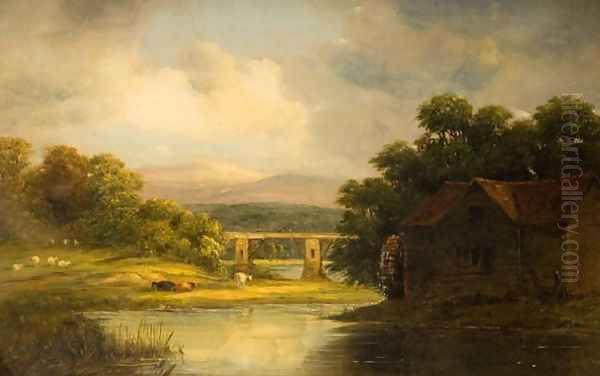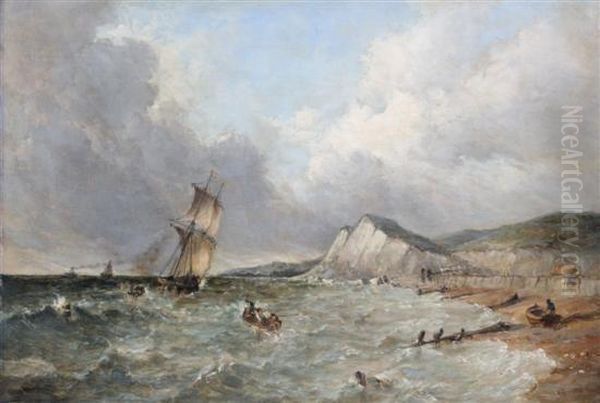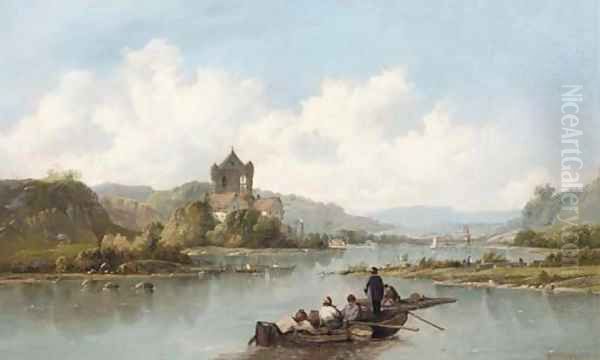Alfred Vickers stands as a notable figure within the rich tradition of British landscape painting. Born in London in 1786 and passing away in Pentonville, Islington, in 1868, his life spanned a period of significant development in the genre. Primarily recognized for his oil paintings and watercolours depicting the serene beauty of the British countryside, Vickers carved out a distinct niche through his dedication to naturalism and his keen observation of light and atmosphere.
Though perhaps not achieving the same level of contemporary fame as some of his peers during his lifetime, Vickers was a prolific and dedicated artist. He developed his skills largely through self-teaching, driven by a profound appreciation for the natural world. His work consistently reflects this connection, offering viewers tranquil and meticulously observed scenes that capture the specific character of the English landscape. His legacy is preserved through numerous works held in public and private collections, attesting to his enduring skill as a painter.
Early Life and Artistic Formation
Alfred Vickers entered the world in St Mary Newington, London, a part of Surrey at the time. Unlike many artists of his era who benefited from formal academic training, Vickers embarked on his artistic journey primarily as a self-taught painter. This path suggests a strong personal drive and an innate talent for observation and representation. He honed his craft by directly studying nature, immersing himself in the landscapes he would come to depict with such sensitivity.
His development was undoubtedly shaped by the burgeoning interest in landscape painting in Britain during the late 18th and early 19th centuries. While specific records of direct mentorship are scarce, the artistic environment of the time provided ample inspiration. The growing appreciation for the national landscape, moving away from the purely idealized scenes of earlier traditions, created fertile ground for artists like Vickers who sought to capture the authentic character of their surroundings.

The influence of major figures in British landscape art cannot be discounted, even if direct interaction wasn't documented. For instance, the work of John Constable (1776-1837), renowned for his fresh, naturalistic oil sketches made outdoors, is noted as an inspiration for Vickers. While evidence doesn't suggest personal acquaintance, Constable's revolutionary approach to capturing the fleeting effects of light and weather likely encouraged Vickers in his own pursuit of direct, unembellished representations of the land he loved. This dedication to observing and sketching directly from nature became a cornerstone of his practice.
Artistic Style and Techniques
Alfred Vickers's artistic style is firmly rooted in Naturalism, with elements of Realism. He sought to represent the world around him with fidelity, focusing on the accurate depiction of landscapes, waterways, and architectural features. His approach was generally characterized by a calm and ordered sensibility, favouring tranquil scenes over dramatic or tumultuous ones. He possessed a remarkable ability to capture the subtle nuances of light and atmosphere, lending his paintings a distinct sense of place and time.
His technique often involved delicate and considered brushwork, particularly in rendering the details of foliage, water surfaces, and architectural elements. However, some accounts also note a broader, more summary handling in certain works, suggesting a focus on overall effect and atmospheric unity rather than minute detail across the entire canvas. This potential variation might reflect different periods in his career or different intentions for specific pieces.
Vickers demonstrated a sophisticated understanding of composition, often balancing areas of land, water, and sky to create harmonious and visually pleasing arrangements. His palette typically favoured soft, naturalistic tones, effectively conveying the gentle light and verdant colours of the English countryside. He paid particular attention to skies and water, capturing reflections and the play of light with considerable skill. This focus on light, combined with clear composition and an avoidance of overt sentimentality, defines the essential character of his work.
Themes and Subjects
Thematically, Alfred Vickers remained consistently focused on landscape throughout his long career. His primary subject matter was the British countryside, particularly the gentle, rolling landscapes, meandering rivers, and picturesque villages of England and Wales. He was adept at capturing the quiet rhythms of rural life, often including small figures or animals – such as resting cattle – to add scale and a touch of narrative interest without overwhelming the natural setting.

River scenes were a recurring motif in his oeuvre. Works depicting the River Medway, for example, showcase his ability to render the reflective qualities of water and the lush vegetation along riverbanks. Coastal and marine subjects also featured in his output, demonstrating his versatility in capturing different types of natural environments, from calm estuaries to potentially more dynamic coastal views, though tranquility remained a dominant mood.
Beyond purely natural landscapes, Vickers also incorporated architectural elements into his compositions. He painted views featuring cottages, farmsteads, ruined mills, and occasionally more prominent structures like churches or elements of cityscapes. His depictions of buildings were handled with the same attention to light and atmosphere as his landscapes, integrating them seamlessly into their surroundings. His work Berlin Guard House, showing the French and German Cathedrals, indicates an engagement with urban European scenes as well, broadening his geographical scope.
Representative Works
Alfred Vickers's extensive output includes many fine examples of British landscape painting. Among his notable works is A River Scene with Figures by a Ruined Mill. This painting exemplifies many of his characteristic strengths: a tranquil river setting, the picturesque element of a ruined structure, carefully placed figures that animate the scene, and a masterful handling of light reflecting on the water and illuminating the landscape. It conveys a sense of peacefulness and gentle decay often found in Romantic-era landscapes.
Another significant work, On the Medway (1861), highlights his affinity for river landscapes. Such paintings typically capture the specific character of the location, focusing on the interplay of water, trees, and sky, rendered with his signature naturalistic approach and sensitivity to atmospheric conditions. These river views are central to his contribution to the genre.
Rural life is beautifully captured in paintings like A Farmstead Among Trees (1848) and Forest Landscape With Resting Cows (1851). These works showcase his ability to depict pastoral scenes with authenticity, focusing on the harmony between human habitation (or animal life) and the surrounding natural environment. The rendering of trees and foliage, along with the peaceful mood, are hallmarks of his style.

His engagement with continental European subjects is evidenced by works such as the pencil drawing View of Potsdam from the Mühlenberg (c. 1833-1836) and the oil painting Berlin Guard House, showing the French and German Cathedrals. The latter is particularly interesting as it was reportedly used as a source for prints in Russia, suggesting a wider reach for his imagery, even if indirectly. These works demonstrate his skill in depicting architectural details within an urban or semi-urban context. His broader production also included numerous English River Landscapes and various marine and coastal scenes.
Exhibitions and Recognition
Throughout his career, Alfred Vickers was a regular exhibitor at London's principal art institutions. He frequently showed his works at the prestigious Royal Academy of Arts, where records indicate he exhibited over one hundred paintings during his lifetime. He also contributed works to exhibitions at the British Institution and the Society of British Artists (later the Royal Society of British Artists) on Suffolk Street. This consistent presence in major exhibitions demonstrates his active participation in the London art world and his commitment to sharing his vision with the public.
Despite this regular exhibition activity, sources suggest that Vickers did not achieve widespread fame or significant financial success during his lifetime. He appears to have been somewhat overshadowed by more prominent or perhaps more dramatically inclined landscape painters of the era. His quieter, more subtle naturalism may not have captured the public imagination to the same extent as the works of some contemporaries. He has been described as an "underappreciated" artist in his own time.
However, his reputation has grown posthumously. His paintings began to attract more attention from collectors and art historians later in the 19th century and into the 20th century. Today, his works are held in the collections of numerous public galleries and museums, primarily in the United Kingdom, confirming his status as a skilled and significant contributor to the British landscape tradition. His paintings are valued for their technical accomplishment, their faithful representation of nature, and their tranquil beauty.
Context and Contemporaries
Alfred Vickers worked during a vibrant period for British landscape painting. His long career overlapped with several key figures who shaped the genre. While he was largely self-taught and perhaps operated somewhat independently, his work inevitably exists in dialogue with the broader artistic currents of his time.
As previously mentioned, John Constable (1776-1837) was a major force whose emphasis on direct observation and capturing the specific atmospheric conditions of Suffolk undoubtedly influenced the direction of naturalistic landscape painting, likely inspiring Vickers even without direct contact. The towering figure of J.M.W. Turner (1775-1851) also dominated the era, though his dramatic, often sublime and increasingly abstract visions of nature offered a stark contrast to Vickers's generally calmer, more topographical approach. There is no evidence suggesting personal interaction between Vickers and Turner.
The legacy of earlier masters like Claude Lorrain (1600-1682), whose idealized classical landscapes had profoundly influenced British art for generations, still lingered. While Vickers's naturalism represented a move away from Claude's style, the tradition of carefully composed, harmonious landscapes provided a foundational context. Vickers lived too late to have known Claude.
Among his closer contemporaries, Vickers shared the landscape field with artists like David Cox (1783-1859) and Peter De Wint (1784-1849), both highly regarded for their watercolour landscapes, though Cox also worked in oils. Their careers ran parallel to Vickers's, contributing to the strength of British landscape art in the first half of the 19th century. The Norwich School painters, including John Crome (1768-1821) and John Sell Cotman (1782-1842), were slightly earlier contemporaries focused on their local Norfolk scenery, further enriching the national landscape tradition.
Other landscape and rural genre painters active during Vickers's time included William Shayer, Senior (1787-1879), whose lifespan closely mirrored Vickers's and whose rustic scenes share some thematic ground, and the younger Thomas Creswick (1811-1869), another Royal Academician known for his detailed depictions of English and Welsh scenery. Thomas James Soper (fl. 1836-1890) is also mentioned as being active alongside Vickers in the mid-19th century. The brief but brilliant career of Richard Parkes Bonington (1802-1828) also left its mark on landscape and marine painting during Vickers's earlier years. It is also important to note that Vickers's son, Alfred Gomersal Vickers (1810-1837), was himself a talented landscape and marine painter whose promising career was cut tragically short by his early death; care must be taken not to confuse the father's long career with the son's brief one.
Later Life and Legacy
Alfred Vickers continued to paint throughout his life, remaining dedicated to his craft until his later years. He passed away in Pentonville, a district within Islington, London, in 1868, at the age of 82. His death marked the end of a long and productive career devoted almost entirely to the depiction of landscape.
His legacy lies in his contribution to the naturalistic strand of British landscape painting. As a largely self-taught artist, his success speaks to his innate talent and persistent observation of the natural world. He excelled at capturing the quiet beauty and specific atmospheric qualities of the British countryside, particularly river scenes and pastoral views. His work offers a valuable record of the landscape as he saw it, rendered with sensitivity and skill.
While he may not have revolutionized the genre in the manner of Constable or Turner, Vickers consistently produced high-quality work that found favour with exhibitors and, increasingly over time, with collectors. His paintings are appreciated for their technical competence, their tranquil mood, and their faithful representation of nature. He holds a secure place among the second tier of highly accomplished British landscape artists of the 19th century.
His works serve as enduring examples of the deep affection for the national landscape that characterized much of British art during his lifetime. They invite viewers to appreciate the subtle beauties of nature through the eyes of an artist who clearly loved his subject matter and dedicated his life to capturing it on canvas and paper.
Conclusion
Alfred Vickers (1786-1868) remains a significant, if sometimes overlooked, figure in the history of British art. His journey as a self-taught artist led him to become a proficient and sensitive painter of landscapes, primarily focusing on the serene aspects of the English countryside, rivers, and coastal areas, as well as occasional urban scenes. His style, rooted in Naturalism, emphasized careful observation, the accurate rendering of light and atmosphere, and harmonious composition.
A prolific exhibitor, particularly at the Royal Academy, Vickers contributed substantially to the artistic output of his time. Although contemporary recognition might have been modest compared to some giants of the era, his work has earned lasting appreciation. His paintings, such as A River Scene with Figures by a Ruined Mill and his many views along the Medway and other rivers, exemplify his skill in capturing the tranquil charm of his native land.
Today, Alfred Vickers is recognized for his dedication to his craft and his valuable contribution to the rich tapestry of 19th-century British landscape painting. His works continue to be admired in public collections and by private collectors, securing his legacy as a painter who expertly chronicled the enduring beauty of the natural world.